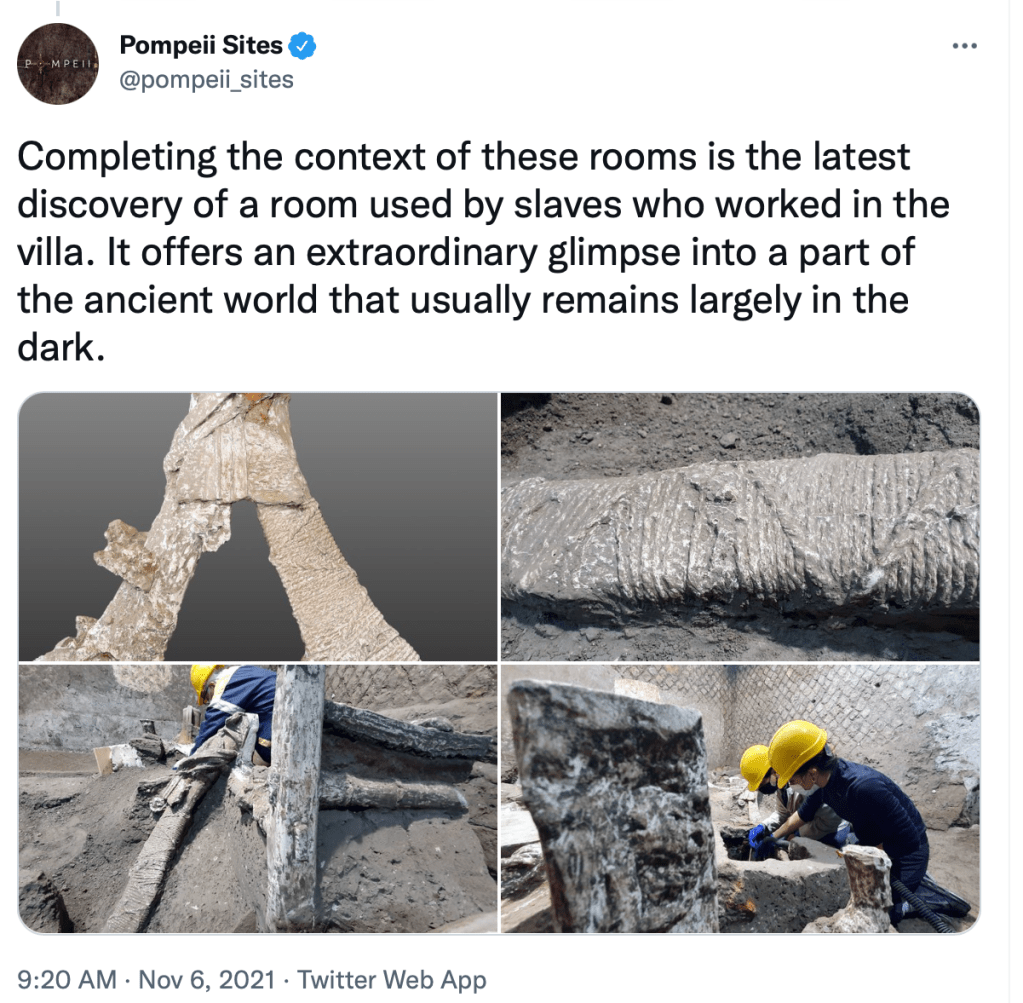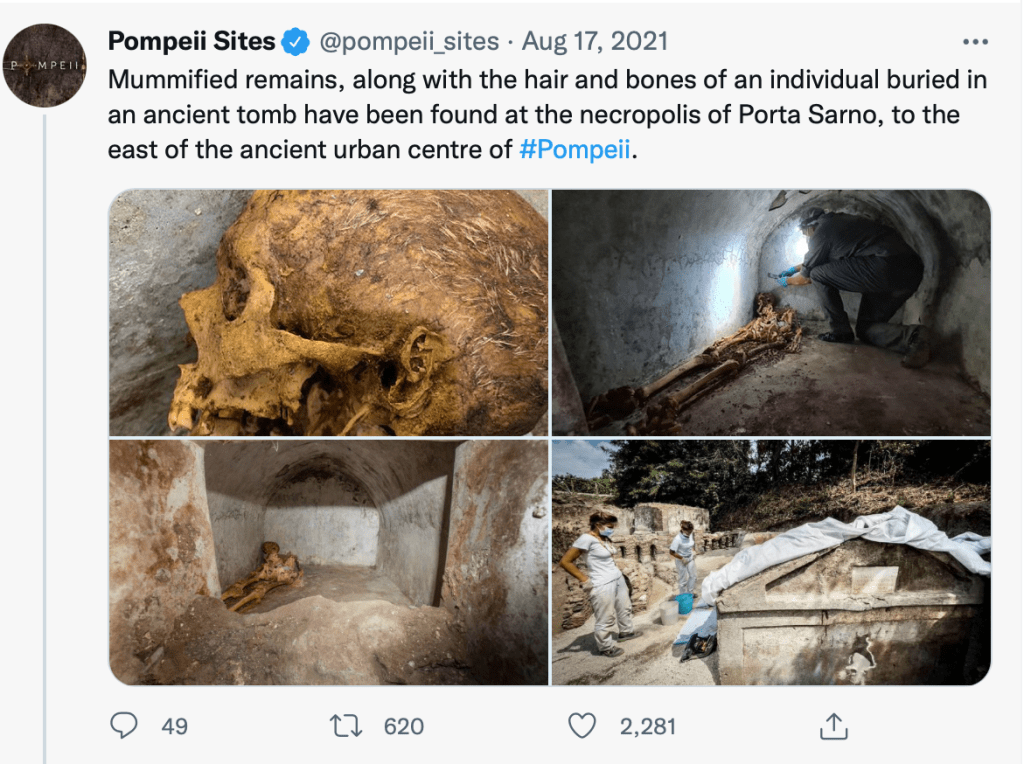Dr Gabriel Zuchtriegel, the director of Pompeii’s archaeological park, delivered the 26th Denys Haynes Memorial Lecture at the British Museum in September 2022. Classics Ambassador Ffion Shute was there for us.
Dr Zuchtriegel was appointed director of the archaeological park at Pompeii last year and is overseeing on-going excavations in several parts of the ancient city. In his talk, he outlined two exciting new finds made just weeks ago: slaves’ quarters with uniquely preserved contents and a large tomb belonging to a wealthy freedman.
Dr Zuchtriegel explained how excavations are taking place in the very northwest of the city, in an area known as the Civita Giuliana, beyond the Villa dei Misteri (Villa of Mysteries). Despite the depredations of past ‘tomb raiders’ in this area, he explained that there is still a wealth of material still to be discovered, including a villa, which has already yielded plenty of archaeological interest, including an intact (and flashy!) ceremonial chariot used for weddings, and stables at the back of the house containing the remains of several horses.

Another room excavated in that villa has been identified as slaves’ quarters. The room adjoined the stables and doubled as a storeroom. Dr Zuchtriegel described in great detail the three beds found in the room, consisting of Ikea-style extendable frames that slotted together. The room was most likely used by slaves because the furniture is so simple and may even have been occupied by a family of slaves because the beds are of varying sizes. Also found under the beds were beakers for a sip of water at night, and their necessary counterparts, chamber pots. Small amphorae for keeping the slaves’ minimal belongings were found nearby. An ingenious method of lighting was found: the slaves had painted the wall bright white around their lamp bracket in order to better reflect the light from their single lamp into the windowless room.

This room is an important discovery in many ways, particularly as a demonstration of what more ordinary furnishings were like, as opposed to the lavish bronze and wooden furniture that is familiar from Herculaneum. This new furniture from Pompeii was recovered by the technique of making plaster casts pioneered by the 19th century archaeologist Giuseppe Fiorelli. These are made by drilling down to the cavity and pouring in plaster, creating a perfect impression of the original object, which can then be excavated without damage. Dr Zuchtriegel’s team have further developed this technique and now use dental plaster, which preserves things like the furniture in extraordinary detail. He described the feeling of pouring the plaster into a cavity, not knowing whether it would produce a fantastic find or if they were pouring unlimited amounts of expensive dental plaster into an animal burrow! Luckily, this particular dig did produce some fantastic finds. The bedframes found in the slaves’ quarters were covered with hammock-like rope windings instead of mattresses. The plaster preserves the details of the tiniest of fibres. It is a rare and moving connection to the ancient world to see in such detail the lives of people with limited visibility in both literary and archaeological sources.

The second part of Dr Zuchtriegel’s talk focused on a tomb excavated last year at the necropolis at Porta Sarno. It is the tomb of a freedman named Venerius Secundio, with a full inscription detailing his titles and achievements. It says that he was a guardian of the temple of Venus and a member of the Augustales, the order of priests who were responsible for the state cult of the deified emperor Augustus. This was a position extensively held by freedmen, so this title is prestigious but not surprising. He was probably of Greek origin, with his sponsorship of performances in Greek a nod to his birthplace. He also appears in the account books of Caecilius the banker but has probably just missed out on being a character in the new edition of the Cambridge Latin Course!

The inscription reads as follows:
VENERIUS COLONIAE LIBERTUS SECUNDIO AEDITUUS VENERIS AUGUSTALIS ET MINISTER EORUM HIC SOLUS LUDOS GRAECOS ET LATINOS QUADRIDUO DEDIT
VENERIUS SECUNDIO, A FREEDMAN OF THE COLONY, GUARDIAN OF THE TEMPLE OF VENUS AND MEMBER OF THE PRIESTHOOD OF AUGUSTUS GAVE FROM ONLY HIS OWN FUNDS FOUR-DAY PERFORMANCES IN GREEK AND LATIN
Something very interesting and unique about Venerius’ tomb was the fact that he was inhumed. Instead of the traditional Roman practice of burying the occupant’s ashes in an amphora, the freedman’s body was placed in a sealed burial chamber within the tomb. Zuchtriegel’s team opened the chamber and was suddenly faced with the extremely time-sensitive and delicate task of removing the man’s remains from his previously airtight resting place. Fortunately, they managed to retrieve his body, which is not a plaster cast like other human remains recovered from Pompeii, but an actual body in a remarkable state of preservation, with details like an ear and even hair surviving. This suggests that the body may have been embalmed.
It is not certain why Venerius chose to be buried rather than cremated. Other amphorae containing ashes were found in the tomb, most likely containing the remains of members of his family. However, Dr Zuchtriegel touched on an intriguing possible explanation here: Nero’s visit to Pompeii. In around the year 64CE, Nero and his then wife Poppaea visited Pompeii and specifically the temple of Venus, the city’s patron deity. Venerius’ tomb specifies that he was a guardian of the temple, and may have joined other local bigwigs for the occasion. Whatever actually happened during Nero’s visit, the freedman would have been very excited and may have wanted to emulate Nero and Poppaea in certain respects. Just as he sponsored Greek performances in life, his inhumation may have been inspired by that of Poppaea, whose body was embalmed and placed in the Mausoleum of Augustus in the year 65CE. Perhaps Venerius’ final wish was to carry on forging his identity as a Roman citizen by copying the imperial family, even in death.
Whatever the truth behind Venerius’ life and death, we can imagine his journey from lying in a bed such as those of the slaves in the stables, to lying in such a sumptuous tomb for us to uncover his story two thousand years later.
©FfionShute

You must be logged in to post a comment.